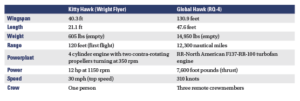From Kitty Hawk to Global Hawk
Aviation is proof that — given the will — we can do the impossible.
— Eddie Rickenbacker
Many years ago, I had the privilege of attending one of Washington’s big black-tie aviation awards dinners. I have long since forgotten both the award and the recipient, but I do remember that dinner as my introduction to the music of Ken Dravis.
I am generally not partial to the genre of country music but, as a family member has wryly observed, “Susan will like anything connected to aviation.” It turns out that Dravis is not only a country singer/songwriter, but also a pilot. So, naturally enough, I went home that night with a CD (remember those?) of his “Hooked on Flight” album, which now lives in my iTunes library along with his two later flight-focused albums.
As we worked on this UAS-themed issue of FAA Safety Briefing, I couldn’t help recalling the words to what is perhaps my favorite song from “Hooked on Flight.” In a thoughtful piece called “Kitty Hawk,” Dravis imagines how the Wright Brothers might react if they could see how far aviation has come since that windy December day at Kitty Hawk:
In time it all came together/It was you who led the way
Your eyes would fill with wonder/If you were here for just a day
We’re a long, long way from Kitty Hawk …
Um, yes. We are indeed a long, long way from aviation’s modest beginnings, having not only gone to the moon — another line in the song — and filled the skies with airplanes longer than any of the Wrights’ first flights, but also moved well into the dawn of the drone era.
As I pondered the incredible Kitty Hawk-to-Global Hawk trajectory of technological progress, I was sufficiently curious to compare a few of the structural and performance characteristics, summarized in the chart below.

Quite a difference, isn’t it?
While it doesn’t mention drones, filmmaker Brian J. Terwilliger’s lovely “Living in the Age of Airplanes” documentary is relevant to this Kitty Hawk-to-Global Hawk reverie of mine because it offers a splendid sense of appreciation of just how much aviation has changed virtually everything about our world — where we can go, what we can buy, what we can do.
It seems that each and every day, we see still more glimpses of just how profoundly the era of UAS will similarly transform our lives. As I observed elsewhere in this issue of the magazine, drones are already allowing us to do old things in new ways, and opening the door to doing new things we couldn’t previously even imagine.
It’s a fascinating thing to watch, and I feel blessed and privileged to live not just in the age of airplanes, but in the age of aviation and all the transformative potential it holds. I hope you do as well. (FAA Safety Briefing – MayJun 2017)
